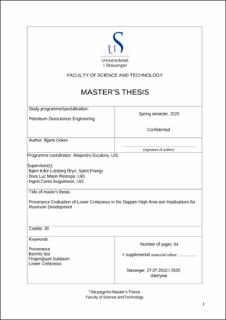| dc.contributor.advisor | Lotsberg Bryn, Bjørn Kåre | |
| dc.contributor.advisor | Luz Marin Restrepo, Dora | |
| dc.contributor.advisor | Augustsson, Ingrid Carita | |
| dc.contributor.author | Usken, Bjarte | |
| dc.date.accessioned | 2020-10-13T09:10:15Z | |
| dc.date.available | 2020-10-13T09:10:15Z | |
| dc.date.issued | 2020-07-28 | |
| dc.identifier.uri | https://hdl.handle.net/11250/2682388 | |
| dc.description | Master's thesis in Petroleum Geosciences Engineering | en_US |
| dc.description.abstract | Southeast directed fluvio-deltaic systems transported across Svalbard during Early Cretaceous are age correlated to southeast progradation deposits in the in Fingerdjupet Subbasin. Both local (few km) and distal (>300 km) source regions has been suggested for this system. The recent exploration well 7321/4-1 drilled on the flank of the basin encountered sandstones in the Lower Cretaceous interval. This well data has not been implemented in the previous studies.
This study uses detrital zircon U/Pb geochronology from well 7321 / 4-1 and 7322 / 7-1 in the Fingerdjupet Subbasin to interpret the source of coarse grain sediments. Palynological analyses, well and seismic data are integrated to interpret the distribution of the sandstones encountered in recent well 7321 / 4-1. The aim of this study is to evaluate the provenance of Lower Cretaceous sandstones in encountered by well 7321 / 4-1 and the implications for reservoir development in the Fingerdjupet Subbasin.
Two seismic units (SU1 and SU2) is defined based on seismic downlap terminations and seismically guided well correlations. The SU1 shows wedge-shaped packages thickening towards fault in the central part of the basin. The SU2 consist of the encountered by well 7321/4-1 and is characterized by shelf-edge clinoforms that prograded southeast into the basin. The dominant detrital zircon age populations in SU2 unit from well 7321 / 4-1 is: (1) 2.6- 2.75, (2) 1.7-1.5 Ga and (3) 1.2-1 Ga. Only a few Detrital Zircon ages were measured in well 7322 / 7-1 and it was thus not possible to compare the result with this well. By comparing Detrital Zircon Ages from the SU2 unit with Lower Cretaceous formations on Svalbard and in the Barents shelf, it became clear that both regions contain similar dominant age distribution.
The source of sediment is interpreted to originate from north Greenland and/or Arctic Canada based on the similar detrital age distribution and the southwestern progradation direction of the clinoforms. Seismic interpretation suggests that the well 7321 / 4-1 penetrates the topsets segment of the shelf-edge clinoforms, which interpreted as a potential sandy system in the topsets. | en_US |
| dc.publisher | University of Stavanger, Norway | en_US |
| dc.relation.ispartofseries | Masteroppgave/UIS-TN-IER/2020; | |
| dc.subject | petroleumsgeologi | en_US |
| dc.title | Provenance Evaluation of Lower Cretaceous in the Stappen High Area and Implications for Reservoir Development | en_US |
| dc.type | Master thesis | en_US |
| dc.subject.nsi | VDP::Matematikk og Naturvitenskap: 400::Geofag: 450::Petroleumsgeologi og -geofysikk: 464 | en_US |
| dc.subject.nsi | VDP::Teknologi: 500::Berg‑ og petroleumsfag: 510::Geoteknikk: 513 | en_US |
